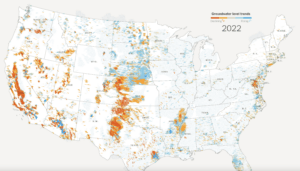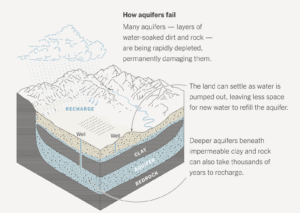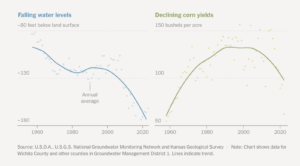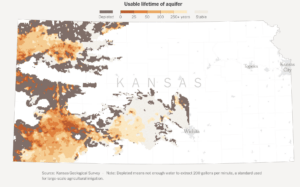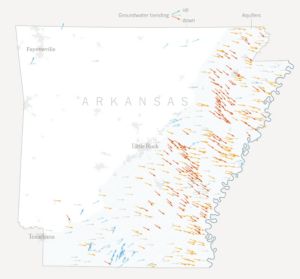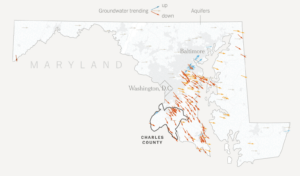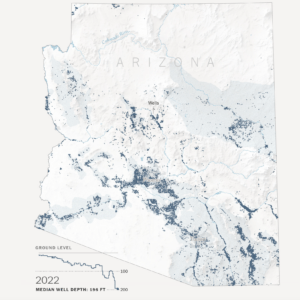BLOG
August 29th, 2023
Courtesy of The New York Times, a report on how groundwater overuse is draining and damaging aquifers nationwide:
-
A wealth of underground water helped create America, its vast cities and bountiful farmland. Now, Americans are squandering that inheritance.
-
The Times analyzed water levels reported at tens of thousands of sites, revealing a crisis that threatens American prosperity.
The 84,544 monitoring wells examined for trends since 1920
-
Nearly half the sites have declined significantly over the past 40 years as more water has been pumped out than nature can replenish.
Sites with falling water levels since 1980
-
In the past decade, four of every 10 sites hit all-time lows. And last year was the worst yet.
Record low annual water levels, past decade
GLOBAL WARMING HAS FOCUSED concern on land and sky as soaring temperatures intensify hurricanes, droughts and wildfires. But another climate crisis is unfolding, underfoot and out of view.
Many of the aquifers that supply 90 percent of the nation’s water systems, and which have transformed vast stretches of America into some of the world’s most bountiful farmland, are being severely depleted. These declines are threatening irreversible harm to the American economy and society as a whole.
The New York Times conducted a months-long examination of groundwater depletion, interviewing more than 100 experts, traveling the country and creating a comprehensive database using millions of readings from monitoring sites. The investigation reveals how America’s life-giving resource is being exhausted in much of the country, and in many cases it won’t come back. Huge industrial farms and sprawling cities are draining aquifers that could take centuries or millenniums to replenish themselves if they recover at all.
States and communities are already paying the price.
Groundwater loss is hurting breadbasket states like Kansas, where the major aquifer beneath 2.6 million acres of land can no longer support industrial-scale agriculture. Corn yields have plummeted. If that decline were to spread, it could threaten America’s status as a food superpower.
Fifteen hundred miles to the east, in New York State, overpumping is threatening drinking-water wells on Long Island, birthplace of the modern American suburb and home to working class towns as well as the Hamptons and their beachfront mansions.
Around Phoenix, one of America’s fastest growing cities, the crisis is severe enough that the state has said there’s not enough groundwater in parts of the county to build new houses that rely on aquifers.
In other areas, including parts of Utah, California and Texas, so much water is being pumped up that it is causing roads to buckle, foundations to crack and fissures to open in the earth. And around the country, rivers that relied on groundwater have become streams or trickles or memories.
“There is no way to get that back,” Don Cline, the associate director for water resources at the United States Geological Survey, said of disappearing groundwater. “There’s almost no way to convey how important it is.”
But despite the importance, the view of the predicament has often been fragmented. Until now.
This analysis is based on tens of thousands of groundwater monitoring wells that dot the nation. The Times collected data for these wells, which are widely scattered and often poorly tracked, from dozens of federal, state and local jurisdictions.
That database reveals the scope of the crisis in many ways. Every year since 1940, for example, more wells have had falling water levels than rising levels.
One of the biggest obstacles is that the depletion of this unseen yet essential natural resource is barely regulated. The federal government plays almost no role, and individual states have implemented a dizzying array of often weak rules.
The problem is also relatively unexamined at the national scale. Hydrologists and other researchers typically focus on single aquifers or regional changes.
All of this helps enable and reinforce practices that have drained aquifers, such as growing water-intensive crops like alfalfa or cotton in dry areas and overreliance on groundwater in fast-growing urban areas.
Several states including Texas, Oklahoma and Colorado have rules that allow groundwater to be pumped from some regions until it’s gone. Some areas have even set official timelines for how quickly they plan to use up groundwater over the next few decades.
Oklahoma is working to determine how much water remains in its aquifers, information that state lawmakers could use to set limits on pumping. But Christopher Neel, the head of water rights for the Oklahoma Water Resources Board, said people might not necessarily welcome the government telling them that their land is running out of groundwater.
“If we start showing that kind of data, that kind of goes into your property values,” Mr. Neel said. “If we show an area may be depleted in, let’s say, two years, well, if someone tries to sell that property, they’re not going to be able to.”
To get the clearest picture possible of the state of groundwater in the United States, The Times interviewed scientists, policymakers and hydrological experts in addition to building its national database of millions of measurements from wells used to measure groundwater depth.
The analysis of that data, some of it collected from wells that have been tracked for a century, enabled The Times to cross-reference water levels over time with crop cover and population patterns. Results were also compared against readings from sophisticated satellites that can estimate groundwater changes from space by measuring subtle shifts in gravity.
Recent data from those satellites, which are operated by the Jet Propulsion Laboratory and funded by NASA, also show aquifers in decline.
Two major California and Arizona aquifers recently matched or exceeded their lowest levels since NASA began collecting data two decades ago, according to research by Bridget Scanlon and Ashraf Rateb at the University of Texas at Austin. And parts of the vast Ogallala Aquifer beneath Kansas, eastern Colorado and the Oklahoma and Texas panhandles, an aquifer that irrigates a huge share of the global food supply, last year reached their lowest levels since the start of NASA’s program. The gravity-measuring satellites are part of NASA’s mission to study the workings of the planet.
Climate change is amplifying the problem.
Global warming is shrinking the snowpack that feeds rivers, increasing the reliance on groundwater to sustain communities, lawns and crops, even as rising temperatures mean that plants need more water. A warmer world also causes more surface water to evaporate, leaving less to seep through the ground to replenish overstressed aquifers.
Even in places experiencing more violent rainstorms because of climate change, the heavier rainfall only helps so much. That’s because much of the water from extreme downpours races away quickly to the ocean, before it can sit and soak into the aquifer below.
It adds up to what might be called a climate trap. As rising temperatures shrink rivers in much of the country, farmers and towns have an incentive to pump more groundwater to make up the difference.
Experts call that a self-defeating strategy. By draining aquifers that filled up over thousands or millions of years, regions risk losing access to that water in the future when they might need it even more, as climate change makes rainfall less predictable or droughts more severe.
“From an objective standpoint, this is a crisis,” said Warigia Bowman, a law professor and water expert at the University of Tulsa. “There will be parts of the U.S. that run out of drinking water.”
EVERYWHERE, THIRSTY FARMS
The most visible symbol of America’s agricultural bounty is the “center pivot” irrigation system, a metal contraption on wheels that is attached to a pump and revolves around a central point. A single arm, mounted with sprinklers, can be as long as half a mile, dispersing hundreds of gallons per minute from a well, 24 hours a day, for weeks or months on end.
Across much of the High Plains, the landscape is dominated by these pivots.
But a visitor to Wichita County, in Western Kansas, will see fewer of them. The reason: There’s little water left to lay down. The wells have begun to go dry.
Irrigation can more than double the amount of corn grown per acre. As farms in the area use up the groundwater, corn yields have declined, erasing decades of gains.
The region offers a glimpse into the future of America’s farming industry if groundwater keeps getting used up.
“We overpumped it,” said Farrin Watt, who has been farming in Wichita County for 23 years. “We didn’t know it was going to run out.”
American agriculture didn’t always rely on pulling huge volumes of water out of the ground. Until the middle of the last century, farmers were mostly limited to relying on rainfall or river water. Smaller wells were mainly just supplements.
But advances in pump technology after World War II created an American agricultural powerhouse, turning the west and the High Plains into a bounty of corn, alfalfa and other crops, delivering yields that surface water alone couldn’t support.
Last year the United States produced 39 percent of global sorghum exports, 32 percent of soybean exports, and 23 percent of corn exports, federal data show. America also exported more cotton than any other country.
That success has relied on pumping up more water than nature could put back.
As recently as the late 1990s, Wichita County farmers produced 165 to 175 bushels of corn per acre, well above the national average. But it came at a cost, requiring farmers to drain the aquifer in order to irrigate their crops. The area gets less than 20 inches of rain a year, on average, about one-third less than the continental United States as a whole — not nearly enough to replace the water being pumped from the ground.
As farmers ran out of water, they increasingly switched to what’s called dryland farming, relying on rain alone.
That change is reflected in corn yields over time. Last year, corn growers nationwide produced an average of 173 bushels per acre. But for Wichita County, the yield was just 70.6 bushels, the lowest in more than six decades. The same is true for neighboring counties, whose yields have fallen to where they were in the 1960s.
Kansas has no mechanism in place to stop its groundwater decline.
The Kansas Geological Survey produces what it calls a lifetime map for the Ogallala Aquifer within state borders. It shows that large areas already lack enough water for commercial agricultural irrigation.
In the parts of Western Kansas where the usable portions of the Ogallala are located, more than one-quarter of the aquifer is at what the survey calls “minimum threshold,” according to Brownie Wilson, water data manager with the Kansas Geological Survey. That means it’s not possible to extract 200 gallons per minute, a standard threshold for large-scale irrigation. Within 50 years, almost half of the aquifer in that area is expected to decline to minimum threshold.
Wichita County and neighboring counties have been one of the first areas in Kansas to get close to the bottom of the aquifer, Mr. Wilson said. But they won’t be the last. “Tomorrow is here today for them, in terms of reduced yields,” he said.
Some farmers say they can adapt, including Mr. Watt, who cited advances in plant genetics and also more efficient irrigation and better land management. Experts say farmers nationwide should make similar changes to ensure remaining groundwater is used as carefully as possible.
But those types of innovations will only work for so long, said Bill Golden, a professor of agricultural economics at Kansas State University. “The loss of water is going to outpace the gain of technology,” he said. “Eventually, we’re going to lose.”
STATES OPEN THE TAPS
It’s not just Kansas depleting its aquifers at a vicious clip. The same thing is playing out in areas around the country.
In Arkansas, one of the country’s biggest users of groundwater, more than twice as much water is being pumped annually from the main agricultural aquifer as rainfall and other sources put back in, according to state data.
In some places, the aquifer has fallen to less than 10 percent of capacity, the Arkansas Department of State warned this year. Arkansas produces roughly half the nation’s rice, a water-intensive crop.
Ayden Massey, a spokeswoman for the Arkansas Department of Agriculture, said the federal government was building projects to divert more surface water to areas with groundwater shortages and that the state was encouraging people to use water more efficiently. Arkansas residents who depend on water for their livelihood “respect the need for water conservation the most,” she said.
In California, an agricultural giant and, like Arkansas, a major groundwater user, the aquifers in at least 76 basins last year were being pumped out faster than they could be replenished by precipitation, a condition known as “overdraft,” according to state numbers.
Unfortunately this year’s unusually wet winter in California, which led to widespread flooding, did only so much to refill those aquifers. That’s because much of the torrent surged through rivers and into the ocean.
In Colorado, like other western states, farming, residential development and reduced precipitation have increasingly strained the state’s groundwater. But Colorado has policies that allow its aquifers to run out.
Kevin Rein is the Colorado official in charge of allocating the state’s groundwater. He said his office does not track how much water remains in Colorado’s section of the Ogallala, or project how much time remains before that water is exhausted, because state lawmakers haven’t given him that authority.
But even without that data, Mr. Rein said, farmers can already see their wells running low on water. “They might say, ‘Tell us something we don’t know,’” he said.
In Maryland, almost three-quarters of monitoring wells have seen their water levels drop over the past 40 years, some by more than 100 feet. Charles County, which contains fast-growing suburbs of Washington, has used most of its groundwater for homes and agriculture. And it isn’t coming back anytime soon.
“Most of the water we’re pulling out of the ground is thousands of years old,” said Jason Groth, the county’s deputy director of planning and growth management. “It’s not like it rains on Monday, and by Saturday it’s in the aquifer.”
Mr. Groth said the county, which gets the vast majority of its water from its own aquifers, will hit a point within a decade where it doesn’t have enough water.
David Abrams, communications director for the Maryland Department of the Environment, said the state was improving its data collection and monitoring, and that its programs “have a strong track record of success in protecting our groundwater resources.”
Charles County is looking at piping in water from elsewhere or building a treatment plant to remove salt from the Potomac River. But that would increase costs as much as tenfold.
DRINKING WATER?? DISAPPEARS
As in Maryland, depletion means many communities could simply run out of drinking water.
A little more than one-third of America’s total volume of drinking water comes from groundwater, according to data from the U.S. Geological Survey. But small and rural communities are disproportionately dependent on wells, which typically cost less than treating and transporting water from rivers and lakes. Of the nation’s 143,070 water systems, 128,362 rely primarily on groundwater, according to the Environmental Protection Agency.
In one particularly stark example, Arizona said in June that it wouldstop granting permission to build houses in the Phoenix area that rely on groundwater, because there wasn’t enough water for the homes that had already been approved.
Arizona has seen an explosion of wells, and they’ve gotten much deeper. In effect, across much of the state, the wells are chasing rapidly falling water levels downward.
Many of the country’s fast-growing communities are in places with limited rainfall, like Arizona, Texas, and Utah, and other areas across the southwest.
The National Association of Home Builders, asked about the wisdom of building houses where water is running out, said the industry was responding to the demands of homebuyers who want to live in those areas.
Susan Asmus, the association’s senior vice president for regulatory affairs, said builders follow the rules that local officials establish. She said it was up to governments to determine where and how it’s appropriate to build homes. The officials who approve those developments “obviously think they can manage the challenges,” Ms. Asmus said in a statement.
The federal government sets rules on groundwater, but not its overuse or depletion, although experts say Congress has the constitutional authority to do so. Overall, federal responsibility for water is scattered among a half-dozen different agencies.
America’s approach to regulating water is “a total mess,” said Upmanu Lall, director of the Columbia Water Center at Columbia University.
The 2021 infrastructure law increased spending for water storage, recycling and desalination programs, which might reduce some groundwater demand. A White House spokesman, Angelo Fernández Hernández, wouldn’t say what the Biden administration’s position was on whether the federal government should regulate groundwater extraction.
Senator Ron Wyden, Democrat of Oregon, represents a state where groundwater depletion is particularly severe. Almost two-thirds of monitoring wells in Oregon show a statistically significant decline in water levels since 1980.
Mr. Wyden is also chairman of the Water and Power Subcommittee, which has jurisdiction over groundwater management. Presented with the Times’s findings, he said the federal government needed to work with states to address what he called “the groundwater crisis.”
Any effort to impose federal oversight would very likely face opposition from agricultural groups. The American Farm Bureau Federation, which represents farmers, said states were best suited to address groundwater problems. The federal government’s role should be to spend money on infrastructure projects and help farmers pay for new technology, according to Courtney Briggs, the federation’s senior director of government affairs.
Overpumping can have other risks beyond diminishing the supply of water. It can also contaminate aquifers in ways that make the remaining water unsafe or undrinkable.
For example, in coastal areas, overpumping can accelerate “saltwater intrusion,” the movement of ocean water into the freshwater aquifer, making it first unappetizing, then unhealthy.
Saltwater intrusion is happening in the Northeast, the mid-Atlantic states, Florida, the Gulf Coast and California. “It’s pretty widespread,” said Dr. Cline of the U.S. Geological Survey.
Consider Long Island in New York. Saltwater is encroaching on parts of the aquifers that provide drinking water for the three million people who live east of Queens and Brooklyn. The Suffolk County Water Authority has had to limit pumping at about 60 of its wells, or 10 percent of the total, according to Dan Dubois, a spokesman.
It’s a reminder that America has been slow to learn the lessons of overpumping. In the first half of the 20th century, wells in Brooklyn and Queens began to show signs of saltwater intrusion. By the middle of the century, some of those wells had to be shut down.
In Norfolk, Va., and other cities around the country, the groundwater is so dangerously depleted that officials are now, at great cost, pumping treated wastewater into the aquifer to try to stop the water levels from falling.
Then, there’s arsenic.
A naturally occurring, cancer-causing heavy metal, arsenic is often trapped in clay, a common soil type. But it can be released into drinking water supplies when aquifers are overpumped, a phenomenon that scientists have documented in countries with less-developed water infrastructure, including Mexico and Vietnam.
Now, as America’s aquifers are depleted, the problem is happening in the United States.
In 2018, Ryan Smith, then a doctoral candidate at Stanford, published a paper showing a link between groundwater depletion and arsenic contamination in the San Joaquin Valley in California. He is now examining similar changes in the San Luis Valley in Colorado.
In general, as people drill deeper wells, the likelihood of arsenic contamination increases, according to Dr. Smith, now a professor at Colorado State University. And as shallower groundwater supplies are depleted, he said, more people are drilling deeper wells.
The technology exists to filter out arsenic from drinking water, Dr. Smith said. But that imposes a cost on low-income families, he added. And it works only if people know their wells have become contaminated in the first place, which can be a particular problem for private well owners, who might not realize what has happened to their water.
THE EARTH CRACKS
The effects of the nation’s dwindling supplies of groundwater are visible in another way: The ground itself is breaking apart.
In southwest Utah, at the edge of an otherwise fast-growing city named Enoch, are the outlines of a neighborhood that appears to have vanished. Streets and sidewalks meander past lots that were once meant for houses but now have only bits of trash and waist-high weeds. The burned-out foundation of a never-completed house marks what might have been.
Arizona, to the south, has 169 miles of mapped earth fissures, according to the Arizona Geological Survey, an office at the University of Arizona. In 2007, a fissure killed a horse that fell into a crack and couldn’t be freed.
In the Houston area, overpumping of groundwater, along with oil extraction, has caused some land to sink by more than 10 feet over the course of decades, according to local officials. In Florida, overpumping sometimes causes sinkholes.
But Enoch, population 8,000 or so, is a glaring example of subsidence.
A developer began laying out a subdivision during the housing boom of the mid-2000s, planning 800 homes. The project went bankrupt, a victim of the housing crash. Then, city workers noticed something that prevented other developers from trying again: an unusual crack in the road. The subdivision, it turned out, sat atop an earth fissure.
Pumping water can cause the earth above an aquifer to slump, collapsing the space left behind by the water that was removed. Once that space is lost, it can no longer hold water.
That process, called subsidence, is happening around the country, and more than 80 percent of it is the result of groundwater use, according to the U.S. Geological Survey. The agency says subsidence has affected more than 47,000 square miles of land and waterways across the United States.
As the land sinks, home foundations, sewer pipes and other structures are damaged. But among the most dramatic consequences of subsidence is a fissure. As softer ground slumps, sometimes an adjacent patch of ground stays put. The resulting movement shears the earth apart.
“We’re sucking water out, and it’s compressing the ground,” said Rob Dotson, Enoch’s city manager.
It’s hard to predict fissures before they open. But once they happen, they can’t easily be filled in or closed. Instead they tend to get both wider and longer.
Enoch’s new neighborhood had to be abandoned. And the fissure has since been detected in another neighborhood nearby, where people already live.
Yet despite knowing the consequences, Enoch has been unable to stop extracting its groundwater, a decision to keep pumping that is being repeated nationwide in cities and on farmland. After all, there are crops to sustain and communities like Enoch that keep growing.
“People are coming and coming and coming,” Mr. Dotson said. And those people need water.


